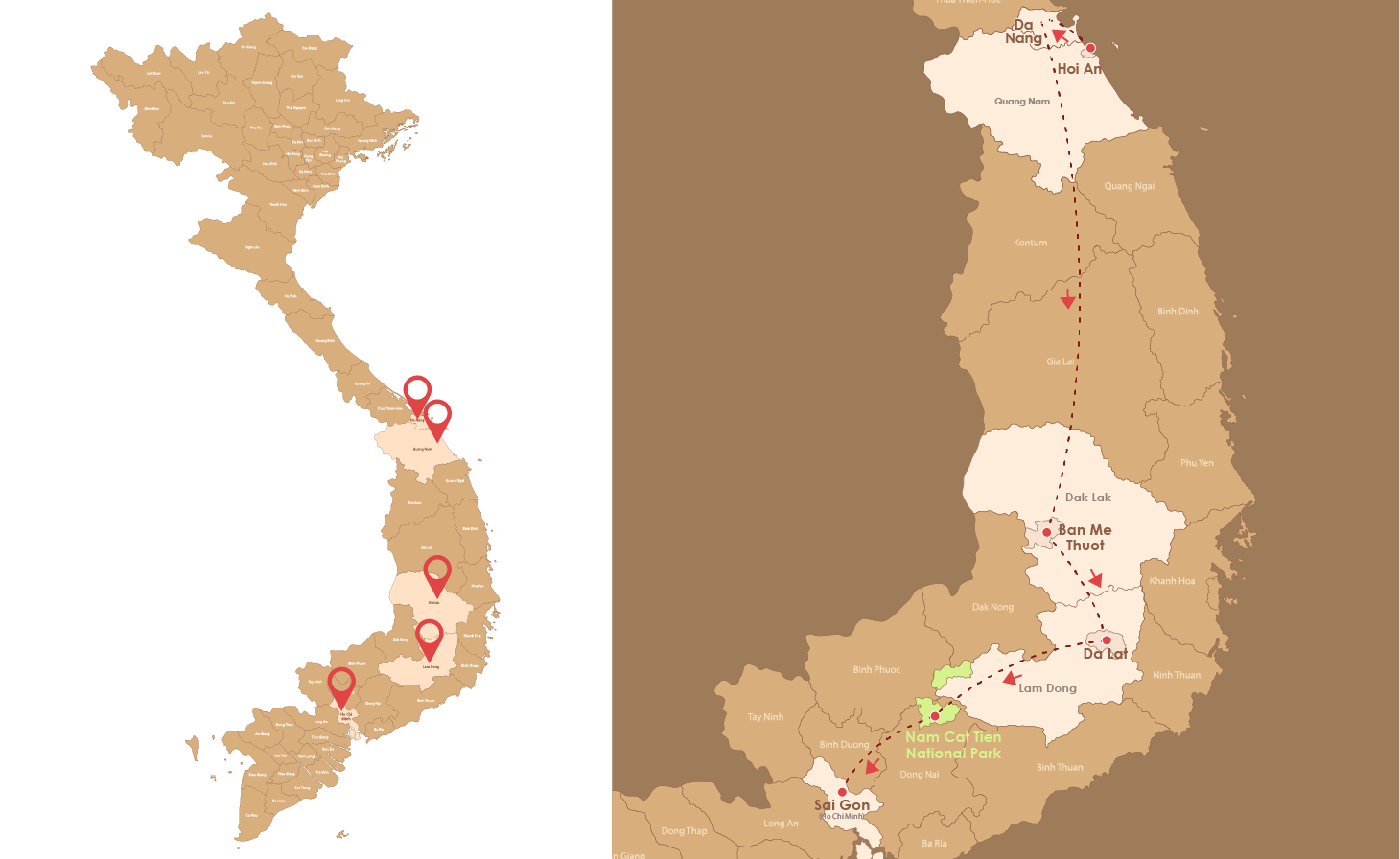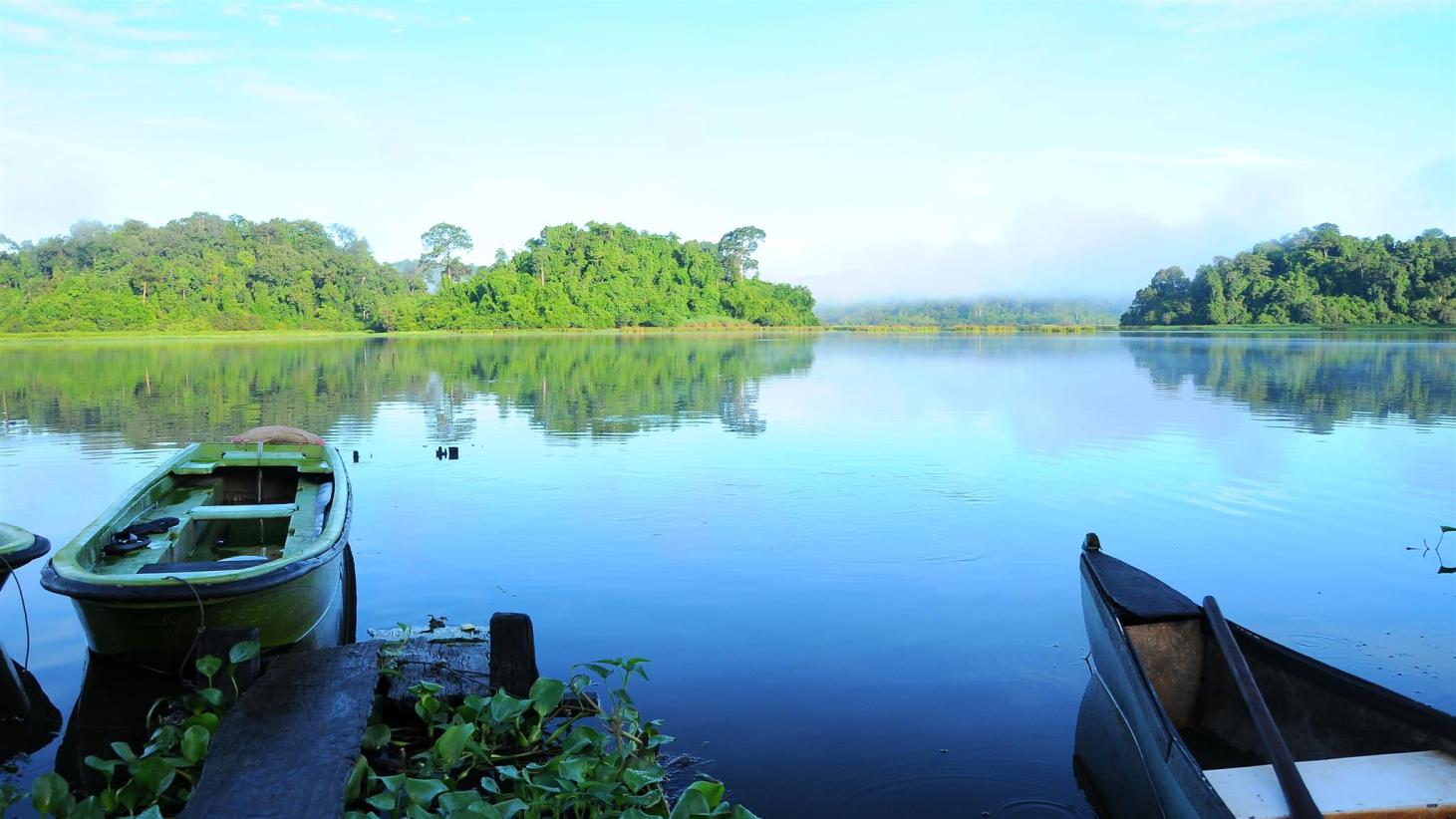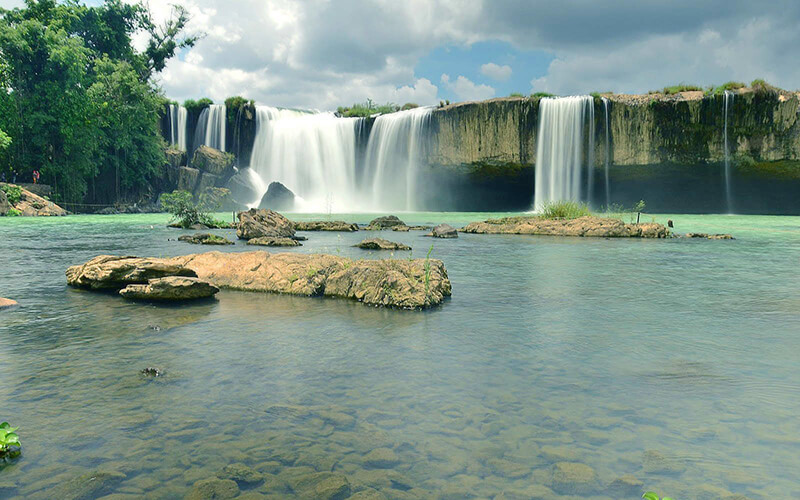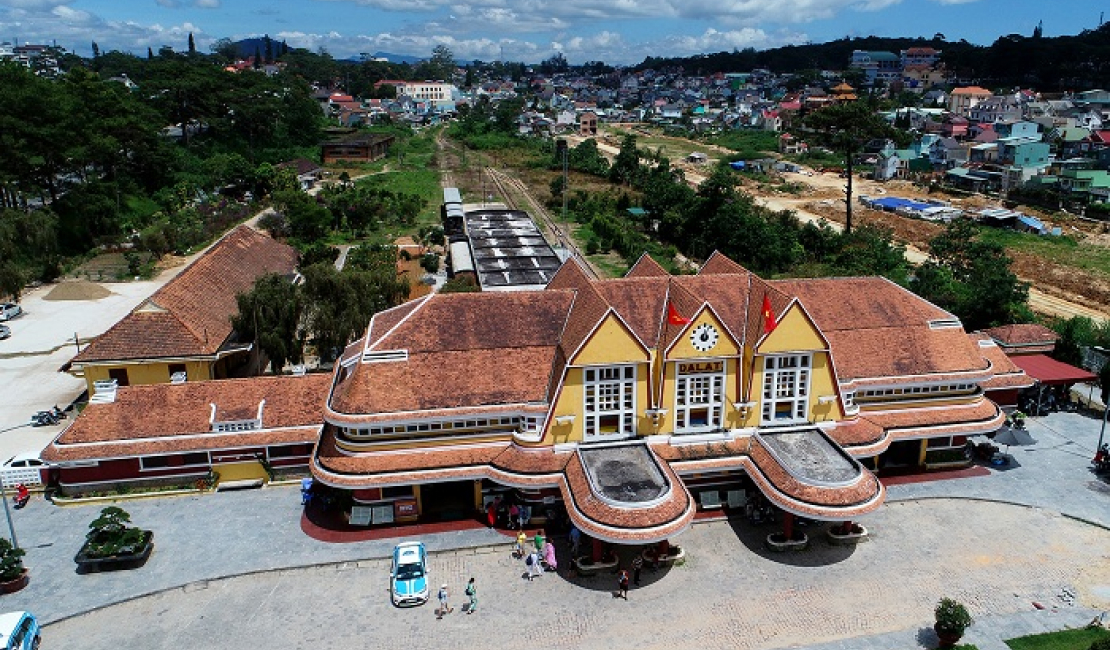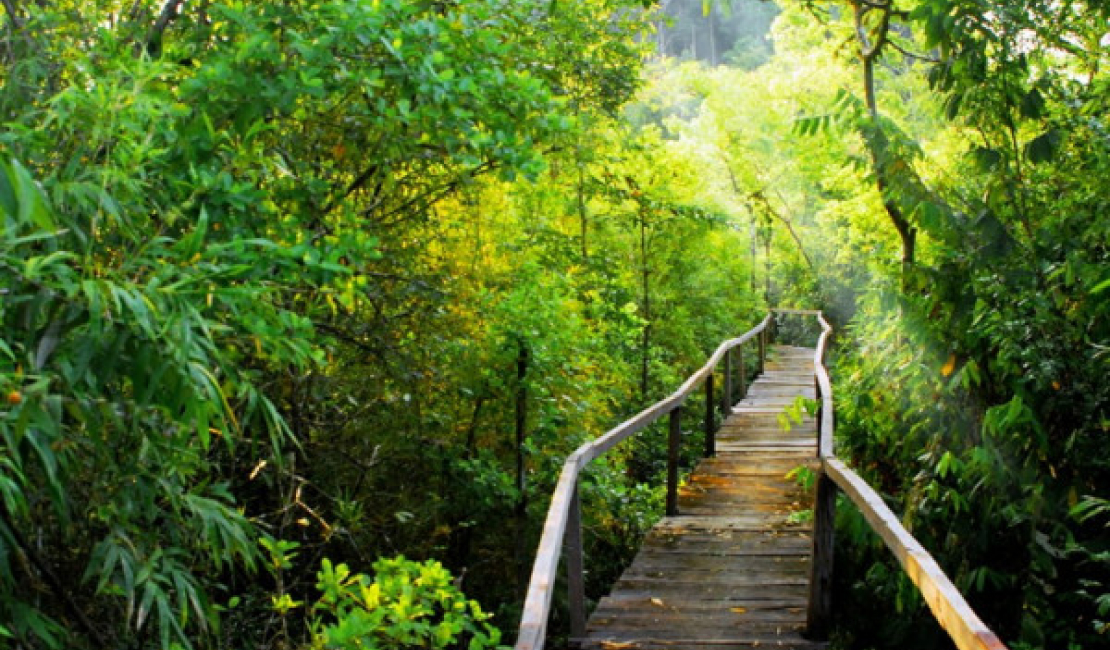THANK FOR YOUR INTEREST
We will contact you soon. How shall we contact you?
Or
Leave us you email
We will contact with you soon. How can we contact you?
HIGHLANDS – CENTER PROVINCE PACKAGE
IN CONSTRUCTION
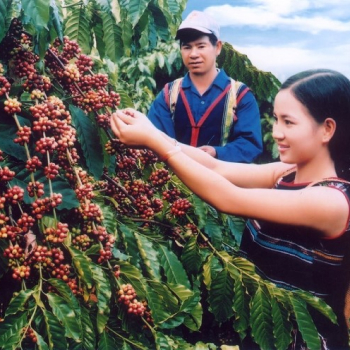

HIGHLIGHTS
- Original route through the Highlands
- Dak Lak (Tented Lak Camp)
- Wildlife in Nam Cat Tien Reserve
Join our 5-day city break to discover the beauty of Vietnam like never before!
Day 1: HOIAN – DANANG – BAN ME THUOT (BY FLIGHT)
After having breakfast at the hotel, you will be taken on a guided walking tour through the old quarters of Tran Phu and Nguyen Thai Hoc. It’s the opportunity to visit many beautiful sites like Fujian Shrine, Phuc Thanh Pagoda, Phuoc Kien Communal House but also the charming traditional wooden houses, and finally the famous Japanese covered bridge.
Relish in the architectural beauty of Hoi An before a taste of its culinary treasure. For lunch, sit on the wooden bench of a local restaurant to discover the delicious specialty of Hoi An: Cao Lau. It’s a savorous meal made of large rice noodles with pork meat and aromatic herbs.
Then, transfer to Danang airport for your flight to Ban Me Thuot.
As soon as you land in the city, your local French-speaking guide will greet you in the exit hall with a sign bearing your name. Transfer to the city center (approximately a 20-minute drive) and check in at your hotel for a good night’s rest before a new day of discoveries.
Ban Me Thuot is the capital city of Đắk Lắk Province in the Central Highlands of Vietnam. Established in 1904 by the French and selected ad the provincial administrative center, the city is nowadays the coffee capital of Vietnam. The region contributes to 60% of Vietnam’s coffee production, which makes the country the world’s second-largest coffee producer.
Day 2: BAN ME THUOT – LAK TENTED CAMP
In the morning, depart from your hotel to Lak lake (approximately 60km/a 1.5-hour drive) from the city center.
Lak lake is the second-largest natural lake in Vietnam, after Ba Be Lake in the Tonkin mountains to the north. It’s 5 km wide, supplied by Krong Ana River, and surrounded by the Mnongs villages. The Mnong are the most populous ethnic tribe in the region and well-known as master elephant tamers.
You’ll arrive at Lak lake around mid-morning and immediately embark on a boat trip to cross the lake and reach your destination: the Lak Tented Camp.
Located on a lookout overlooking the spectacular Lak Lake, Lak Tented Camp offers creative and exhilarating activities for those escaping the buzzing atmosphere of the city. It’s a little piece of heaven designed to consider environmental challenges, respectful tourism, and cultural exchanges.
For your arrival, a welcome lunch will be served in the Camp’s stilt house restaurant. In the afternoon, take a stroll to explore the village, immerse in the local’s life, and discover their traditional longhouses. You will then be taken on a canoe trip around the lake.
Returning from your aquatic activity, sit back and enjoy a traditional music show and dance, accompanied by a tasting of “ruou can” (rice wine).
At the end of the day, you’ll be transferred to your canvas bungalow overlooking the lake.
Dinner and overnight at the Camp.
Day 3: LAK TENTED CAMP – DALAT
After breakfast, you will be transferred to the beautiful region of Dalat, approximately a 4-hour drive from the Camp.
For coffee enthusiasts, Dalat is considered the Mecca of Arabica coffee and has earned its place in The World Atlas of Coffee. Located in the Lang Biang plateaus at an altitude of 1500m, the region was discovered in the 20th century by Doctor Alexandre Yersin and was officially established as a French resort town in 1920. Nicknamed “Petit Paris”, this city is a place adored by lovers around the country for its tranquility and heavenly landscapes.
Arrive in the early afternoon in Dalat and enjoy lunch at a local restaurant, before starting a local tour. Your first top is the Museum of Biology, a research institute investigating and studying the regional flora and fauna in the Western highland area of Vietnam.
Then, you will be transferred to Bao Dai III Residence for the more history-oriented part of the visit. Bao Dai III Residence was the home of the last Emperor Bao Dai and his family on the eve of his abdication. Its design, conceived by French architect Versseyre, reflects modern royal luxury.
After checking in at your hotel, the rest of the day is free to enjoy as you wish.
Day 4: DALAT – NAM CAT TIEN
Start the day with a delicious breakfast at your hotel before visiting Mr. Son Mai Pacamara’s farm, one of the most well-known Arabica coffee producers in Dalat. You will have the great opportunity to participate in the “From farm to cup” workshop to observe the work of the coffee farmers: from picking to cleaning and drying coffee beans. At the end of the workshop, you will be able to prepare and enjoy your own cup of coffee.
Then, it’s time to depart towards the South in direction of Nam Cat Tien National Park (approximately 170km/a 3-hour drive). Lunch will be served along the route to Bao Loc.
Cát Tiên National Park is a vast lowland tropical forest and biosphere reserve, inaugurated in 1998. southern Vietnam. In 2001, it has been listed by UNESCO as the 411th biosphere Reserve Zone in the world. With a natural area of 71,920 km2, the park is home to more than 1,610 different plants, 105 species of mammals, 351 species of birds, 120 species of reptiles and amphibians, 130 species of freshwater fish, and several hundred species of butterflies and insects. The park shelters also an incredible variety of wildlife, including Javan rhinoceros, which was, unfortunately, officially declared extinct in 2011. Nevertheless, the park is now home to several endangered species such as the black gibbon, the yellow-cheeked gibbon, rare birds, reptiles and the clouded leopard.
Just outside of the park on the Đồng Nai river, the Cát Tiên archaeological site has ancient temples and artifacts. As you’ll arrive at the end of the day at Nam Cat Tien, you’ll have to immediately check in at Cat Tien Jungle Lodge.
Dinner and overnight at the hotel.
Day 5: NAM CAT TIEN – HO CHI MINH CITY
After a hearty breakfast, embark on a morning boat ride along Dong Nai River for a visit at Dao Tien Endangered Primate Species Centre.
The construction is a purpose-built primate rescue center located on a 56 ha island on the edge of Cat Tien National Park. The center was founded in 2008 by Dr. Marina Kenyon Ann, with the help of Monkey World Ape-Rescue UK, and in collaboration with the Vietnamese Ministry of Agriculture and Rural Development. The center’s purpose is to launch a rescue project for the yellow cheek gibbon and create a safe environment for them.
Lunch will be served at a local restaurant, before one final departure to Saigon (approximately 160km/a 3.5-hour drive).
Ho Chi Minh City, when it was still called Saigon, was nicknamed “Pearl of the Orient” and “The Paris of Asia”. Founded under the Second Empire, Saigon was the capital of Cochinchina (today Nam Bô), the only territory constituted as a French colony (the other two, Tonkin and Annam, were protectorates). It’s the country’s economic capital and one of the liveliest cities in Vietnam and south-east Asia.
Useful Information
Available everyday
From 6 yo till 99 yo
